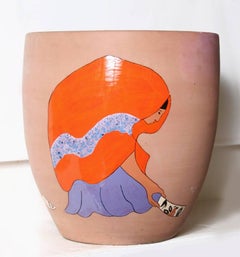R C Gorman Pottery
1990s Folk Art Figurative Sculptures
Terracotta, Glaze
People Also Browsed
Vintage 1980s North American Vases
Ceramic
Antique 1880s Victorian Drop-leaf and Pembroke Tables
Walnut
20th Century Spanish Rustic Fireplace Tools and Chimney Pots
Copper
Early 20th Century Federal Fireplace Tools and Chimney Pots
Brass
Antique Late 19th Century French Belle Époque Armchairs
Upholstery, Giltwood
Mid-20th Century Chinese Other Figurative Sculptures
Porcelain
Antique Late 18th Century American Chippendale Side Chairs
Late 20th Century Realist Figurative Prints
Lithograph
Antique 19th Century American Victorian Fireplace Tools and Chimney Pots
Copper
Late 20th Century Realist Figurative Prints
Paper, Lithograph
Antique Late 19th Century American Steampunk More Furniture and Collecti...
Copper
20th Century Italian Figurative Sculptures
Murano Glass
1970s Contemporary Nude Prints
Lithograph
Antique Mid-19th Century Spanish Scientific Instruments
Copper
Antique Mid-19th Century French Tea Sets
Copper
Vintage 1980s North American Vases
Ceramic
R.C. Gorman for sale on 1stDibs
Rudolph Carl Gorman was an American artist, born on July 26, 1931, in Canyon de Chelly, Arizona. He was raised in a traditional hogan, on the Navajo Reservation. He became one of the Southwest USA's most famous and celebrated Native American artists. His signature works were Navajo women in a variety of poses. Referred to as the Picasso of American Indian Artists by The New York Times, his paintings are primarily of Native American women and characterized by fluid forms and vibrant colors, though he also worked in sculpture, ceramics and stone lithography. In 1973, the Metropolitan Museum of Art included several Rudolph’s works in an exhibition on Native American art and in 1986, Harvard University honored him for his notable contributions to American art and Native American culture. His admirers included Andy Warhol, who painted him on several occasions and who was among the many celebrities, who collected his art. He was also the author of a series of popular cookbooks. Gorman died on November 3, 2005, in Albuquerque, New Mexico.
Finding the Right Figurative-sculptures for You
Figurative sculptures mix reality and imagination, with the most common muse being the human body. Animals are also inspirations for these sculptures, along with forms found in nature.
While figurative sculpture dates back over 35,000 years, the term came into popularity in the 20th century to distinguish it from abstract art. It was aligned with the Expressionist movement in that many of its artists portrayed reality but in a nonnaturalistic and emotional way. In the 1940s, Alberto Giacometti — a Swiss-born artist who was interested in African art, Cubism and Surrealism — created now-iconic representational sculptures of the human figure, and after World War II, figurative sculpture as a movement continued to flourish in Europe.
Lucian Freud and Francis Bacon were some of the leading figurative artists during this period. Artists like Jeff Koons and Maurizio Cattelan propelled the evolution of figurative sculpture into the 21st century.
Figurative sculptures can be whimsical, uncanny and beautiful. Their materials range from stone and wood to metal and delicate ceramics. Even in smaller sizes, the sculptures make bold statements. A bronze sculpture by Salvador Dalí enhances a room; a statuesque bull by Jacques Owczarek depicts strength with its broad chest while its thin legs speak of fragility. Figurative sculptures allow viewers to see what is possible when life is reimagined.
Browse 1stDibs for an extensive collection of figurative sculptures and find the next addition to your collection.
